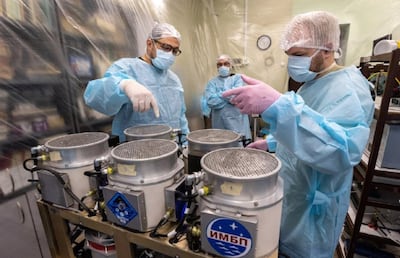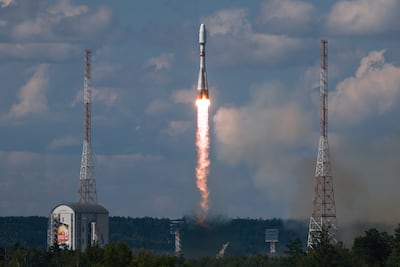Russia is preparing to launch 75 mice and 1,000 fruit flies into space as part of a month-long mission that will show how cosmic radiation affects living organisms.
The research by Roscosmos, Russia’s space agency, and the Institute of Biomedical Problems could prove helpful as agencies set their sights on resuming manned missions to the Moon, and eventually to Mars.
The mice and flies, as well as plant seeds, algae, microorganisms and cell cultures, will be loaded on to the Bion-M No 2 biosatellite, scheduled to be launched on August 20 from Kazakhstan. It will travel around the Earth for 30 days.
The spacecraft will orbit in a region where cosmic radiation is much higher than what astronauts experience aboard the International Space Station, Roscosmos said on Telegram.
“Mice and flies will soon be sent into space,” the post said. “They will help scientists understand how space phenomena affect living organisms in the range where the level of cosmic radiation is approximately 30 per cent higher than in near-Earth orbit. This is important for preparing people for long-distance space flights.”
The study will compare three groups of mice – one living in normal conditions on Earth, a second kept in identical flight hardware in a laboratory on Earth and the third sent into space.
Cameras, sensors and implanted chips will monitor the rodents and allow researchers to track changes to their hormones, immunity and metabolism.
‘Mini-hotel’ for mice
The mice will be placed in a unit described by Roscosmos as a “miniature hotel". It has its own lighting, ventilation, feeding and waste disposal systems.
The mission carries five modules, four stocked with paste-like food that also boosts hydration and one unit where “premium passengers” will dine on dry food and water in gel form.
The use of cell cultures could also help to deepen our understanding of how radiation alters biological processes at every scale.
Scientists have known for decades that radiation is one of the biggest barriers to long-term human space travel. Earth is shielded by radiation by its atmosphere and magnetic field, but deep space exposes astronauts to cosmic rays and bursts of solar radiation.
Bigger picture
Dr Dimitra Atri, principal investigator at NYU Abu Dhabi’s space exploration laboratory, told The National that the risks of travelling through deep space are often underestimated.
“Space radiation is relentless and deeply underestimated," he said. "Researching how radiation impacts life is crucial for protecting astronauts during extended missions to the Moon and beyond, as it helps develop effective shielding, medical countermeasures and mission protocols to reduce long-term health risks."
“Without aggressive research, our dreams of living and working beyond low Earth orbit will remain fantasies. If we don’t tackle this head on, future astronauts could pay a steep price with health.”
The Apollo missions of the 1960s and 1970s tackled the issue by limiting how long astronauts could remain on the surface of the Moon. But with Nasa's Artemis programme, the US space agency and its partners are preparing for missions that could last weeks and months, exposing astronauts to higher doses of radiation. Mars missions, which could last two to three years, would be even more challenging.
China and Russia are also developing a lunar research station, with China aiming to send an astronaut to the Moon before 2030.
Dr Ashok Narayanamoorthi, a space medicine expert, told The National previously that secondary radiation was the main problem facing astronauts. “It bombards the space capsule or your habitat and enters as secondary harmful radiation. Protective clothing available so far is very bulky … it can’t be easily used for daily life," he added.
Revival of Soviet legacy
Russia has a long history of sending animals into space, dating back to the Soviet era when a dog named Laika became the first living creature to orbit Earth aboard Sputnik 2 in 1957.
Over the decades, dogs, monkeys and other small animals were launched on flights to test the limits of life beyond Earth’s atmosphere.
Bion-M No 1 launched in 2013, carrying mice, geckos and other organisms for a 30-day flight.
This latest mission reflects Russia’s hope to remain a key player in biological space research, even as international collaboration with Roscosmos has dropped since the outbreak of war with Ukraine.
Cricket World Cup League 2 Fixtures
Saturday March 5, UAE v Oman, ICC Academy (all matches start at 9.30am)
Sunday March 6, Oman v Namibia, ICC Academy
Tuesday March 8, UAE v Namibia, ICC Academy
Wednesday March 9, UAE v Oman, ICC Academy
Friday March 11, Oman v Namibia, Sharjah Cricket Stadium
Saturday March 12, UAE v Namibia, Sharjah Cricket Stadium
UAE squad
Ahmed Raza (captain), Chirag Suri, Muhammad Waseem, CP Rizwan, Vriitya Aravind, Asif Khan, Basil Hameed, Rohan Mustafa, Kashif Daud, Zahoor Khan, Junaid Siddique, Karthik Meiyappan, Akif Raja, Rahul Bhatia
Five personal finance podcasts from The National
To help you get started, tune into these Pocketful of Dirham episodes
·
Balance is essential to happiness, health and wealth
·
What is a portfolio stress test?
·
What are NFTs and why are auction houses interested?
·
How gamers are getting rich by earning cryptocurrencies
·
Should you buy or rent a home in the UAE?
360Vuz PROFILE
Date started: January 2017
Founder: Khaled Zaatarah
Based: Dubai and Los Angeles
Sector: Technology
Size: 21 employees
Funding: $7 million
Investors: Shorooq Partners, KBW Ventures, Vision Ventures, Hala Ventures, 500Startups, Plug and Play, Magnus Olsson, Samih Toukan, Jonathan Labin
Dust and sand storms compared
Sand storm
- Particle size: Larger, heavier sand grains
- Visibility: Often dramatic with thick "walls" of sand
- Duration: Short-lived, typically localised
- Travel distance: Limited
- Source: Open desert areas with strong winds
Dust storm
- Particle size: Much finer, lightweight particles
- Visibility: Hazy skies but less intense
- Duration: Can linger for days
- Travel distance: Long-range, up to thousands of kilometres
- Source: Can be carried from distant regions
PREMIER LEAGUE FIXTURES
Tuesday (UAE kick-off times)
Leicester City v Brighton (9pm)
Tottenham Hotspur v West Ham United (11.15pm)
Wednesday
Manchester United v Sheffield United (9pm)
Newcastle United v Aston Villa (9pm)
Norwich City v Everton (9pm)
Wolves v Bournemouth (9pm)
Liverpool v Crystal Palace (11.15pm)
Thursday
Burnley v Watford (9pm)
Southampton v Arsenal (9pm)
Chelsea v Manchester City (11.15pm)
ELECTION%20RESULTS
%3Cp%3EMacron%E2%80%99s%20Ensemble%20group%20won%20245%20seats.%26nbsp%3B%3C%2Fp%3E%0A%3Cp%3EThe%20second-largest%20group%20in%20parliament%20is%20Nupes%2C%20a%20leftist%20coalition%20led%20by%20Jean-Luc%20Melenchon%2C%20which%20gets%20131%20lawmakers.%26nbsp%3B%3C%2Fp%3E%0A%3Cp%3EThe%20far-right%20National%20Rally%20fared%20much%20better%20than%20expected%20with%2089%20seats.%3C%2Fp%3E%0A%3Cp%3EThe%20centre-right%20Republicans%20and%20their%20allies%20took%2061.%3C%2Fp%3E%0A
Bib%20Gourmand%20restaurants
%3Cp%3EAl%20Khayma%0D%3Cbr%3EBait%20Maryam%0D%3Cbr%3EBrasserie%20Boulud%0D%3Cbr%3EFi'lia%0D%3Cbr%3Efolly%0D%3Cbr%3EGoldfish%0D%3Cbr%3EIbn%20AlBahr%0D%3Cbr%3EIndya%20by%20Vineet%0D%3Cbr%3EKinoya%0D%3Cbr%3ENinive%0D%3Cbr%3EOrfali%20Bros%0D%3Cbr%3EReif%20Japanese%20Kushiyaki%0D%3Cbr%3EShabestan%0D%3Cbr%3ETeible%3C%2Fp%3E%0A
COMPANY%20PROFILE
%3Cp%3E%3Cstrong%3ECompany%20name%3A%3C%2Fstrong%3E%20Revibe%20%0D%3Cbr%3E%3Cstrong%3EStarted%3A%3C%2Fstrong%3E%202022%0D%3Cbr%3E%3Cstrong%3EFounders%3A%3C%2Fstrong%3E%20Hamza%20Iraqui%20and%20Abdessamad%20Ben%20Zakour%20%0D%3Cbr%3E%3Cstrong%3EBased%3A%3C%2Fstrong%3E%20UAE%20%0D%3Cbr%3E%3Cstrong%3EIndustry%3A%3C%2Fstrong%3E%20Refurbished%20electronics%20%0D%3Cbr%3E%3Cstrong%3EFunds%20raised%20so%20far%3A%3C%2Fstrong%3E%20%2410m%20%0D%3Cbr%3E%3Cstrong%3EInvestors%3A%20%3C%2Fstrong%3EFlat6Labs%2C%20Resonance%20and%20various%20others%0D%3C%2Fp%3E%0A
Apple's%20Lockdown%20Mode%20at%20a%20glance
%3Cp%3EAt%20launch%2C%20Lockdown%20Mode%20will%20include%20the%20following%20protections%3A%3C%2Fp%3E%0A%3Cp%3E%3Cstrong%3EMessages%3A%3C%2Fstrong%3E%20Most%20attachment%20types%20other%20than%20images%20are%20blocked.%20Some%20features%2C%20like%20link%20previews%2C%20are%20disabled%3C%2Fp%3E%0A%3Cp%3E%3Cstrong%3EWeb%20browsing%3A%3C%2Fstrong%3E%20Certain%20complex%20web%20technologies%2C%20like%20just-in-time%20JavaScript%20compilation%2C%20are%20disabled%20unless%20the%20user%20excludes%20a%20trusted%20site%20from%20Lockdown%20Mode%3C%2Fp%3E%0A%3Cp%3E%3Cstrong%3EApple%20services%3A%20%3C%2Fstrong%3EIncoming%20invitations%20and%20service%20requests%2C%20including%20FaceTime%20calls%2C%20are%20blocked%20if%20the%20user%20has%20not%20previously%20sent%20the%20initiator%20a%20call%20or%20request%3C%2Fp%3E%0A%3Cp%3E%3Cstrong%3EConnectivity%3A%3C%2Fstrong%3E%20Wired%20connections%20with%20a%20computer%20or%20accessory%20are%20blocked%20when%20an%20iPhone%20is%20locked%3C%2Fp%3E%0A%3Cp%3E%3Cstrong%3EConfigurations%3A%3C%2Fstrong%3E%20Configuration%20profiles%20cannot%20be%20installed%2C%20and%20the%20device%20cannot%20enroll%20into%20mobile%20device%20management%20while%20Lockdown%20Mode%20is%20on%3C%2Fp%3E%0A
Company profile
Name: Steppi
Founders: Joe Franklin and Milos Savic
Launched: February 2020
Size: 10,000 users by the end of July and a goal of 200,000 users by the end of the year
Employees: Five
Based: Jumeirah Lakes Towers, Dubai
Financing stage: Two seed rounds – the first sourced from angel investors and the founders' personal savings
Second round raised Dh720,000 from silent investors in June this year
Crime%20Wave
%3Cp%3EHeavyweight%20boxer%20Fury%20revealed%20on%20Sunday%20his%20cousin%20had%20been%20%E2%80%9Cstabbed%20in%20the%20neck%E2%80%9D%20and%20called%20on%20the%20courts%20to%20address%20the%20wave%20of%20more%20sentencing%20of%20offenders.%26nbsp%3B%3C%2Fp%3E%0A%3Cp%3ERico%20Burton%2C%2031%2C%20was%20found%20with%20stab%20wounds%20at%20around%203am%20on%20Sunday%20in%20Goose%20Green%2C%20Altrincham%20and%20subsequently%20died%20of%20his%20injuries.%3C%2Fp%3E%0A%3Cp%3E%26nbsp%3B%E2%80%9CMy%20cousin%20was%20murdered%20last%20night%2C%20stabbed%20in%20the%20neck%20this%20is%20becoming%20ridiculous%20%E2%80%A6%20idiots%20carry%20knives.%20This%20needs%20to%20stop%2C%E2%80%9D%0D%20Fury%20said.%20%E2%80%9CAsap%2C%20UK%20government%20needs%20to%20bring%20higher%20sentencing%20for%20knife%20crime%2C%20it%E2%80%99s%20a%20pandemic%20%26amp%3B%20you%20don%E2%80%99t%20know%20how%20bad%20it%20is%20until%20%5Bit%E2%80%99s%5D%201%20of%20your%20own!%3C%2Fp%3E%0A
UAE currency: the story behind the money in your pockets
Key facilities
- Olympic-size swimming pool with a split bulkhead for multi-use configurations, including water polo and 50m/25m training lanes
- Premier League-standard football pitch
- 400m Olympic running track
- NBA-spec basketball court with auditorium
- 600-seat auditorium
- Spaces for historical and cultural exploration
- An elevated football field that doubles as a helipad
- Specialist robotics and science laboratories
- AR and VR-enabled learning centres
- Disruption Lab and Research Centre for developing entrepreneurial skills
MATCH INFO
Fulham 0
Aston Villa 3 (Grealish 4', Hourihane 15', Mings 48')
Man of the match: Jack Grealish (Aston Villa)
Tips%20for%20holiday%20homeowners
%3Cp%3EThere%20are%20several%20factors%20for%20landlords%20to%20consider%20when%20preparing%20to%20establish%20a%20holiday%20home%3A%3C%2Fp%3E%0A%3Cul%3E%0A%3Cli%3E%3Cstrong%3ERevenue%20potential%20of%20the%20unit%3A%3C%2Fstrong%3E%20location%2C%20view%20and%20size%3C%2Fli%3E%0A%3Cli%3E%3Cstrong%3EDesign%3A%20furnished%20or%20unfurnished.%3C%2Fstrong%3E%20Is%20the%20design%20up%20to%20standard%2C%20while%20being%20catchy%20at%20the%20same%20time%3F%3C%2Fli%3E%0A%3Cli%3E%3Cstrong%3EBusiness%20model%3A%3C%2Fstrong%3E%20will%20it%20be%20managed%20by%20a%20professional%20operator%20or%20directly%20by%20the%20owner%2C%20how%20often%20does%20the%20owner%20wants%20to%20use%20it%20for%20personal%20reasons%3F%3C%2Fli%3E%0A%3Cli%3E%3Cstrong%3EQuality%20of%20the%20operator%3A%3C%2Fstrong%3E%20guest%20reviews%2C%20customer%20experience%20management%2C%20application%20of%20technology%2C%20average%20utilisation%2C%20scope%20of%20services%20rendered%3C%2Fli%3E%0A%3C%2Ful%3E%0A%3Cp%3E%3Cem%3ESource%3A%20Adam%20Nowak%2C%20managing%20director%20of%20Ultimate%20Stay%20Vacation%20Homes%20Rental%3C%2Fem%3E%3C%2Fp%3E%0A
UK-EU trade at a glance
EU fishing vessels guaranteed access to UK waters for 12 years
Co-operation on security initiatives and procurement of defence products
Youth experience scheme to work, study or volunteer in UK and EU countries
Smoother border management with use of e-gates
Cutting red tape on import and export of food
Profile Idealz
Company: Idealz
Founded: January 2018
Based: Dubai
Sector: E-commerce
Size: (employees): 22
Investors: Co-founders and Venture Partners (9 per cent)
RESULTS
5pm Maiden (PA) Dh70,000 (Dirt) 1,400m
Winner AF Nashrah, Tadhg O’Shea (jockey), Ernst Oertel (trainer)
5.30pm Maiden (PA) Dh70,000 (D) 1,400m
Winner Mutaqadim, Riccardo Iacopini, Ibrahim Al Hadhrami.
6pm Maiden (PA) Dh70,000 (D) 1,600m
Winner Hameem, Jose Santiago, Abdallah Al Hammadi.
6.30pm Maiden (PA) Dh70,000 (D) 1,600m
Winner AF Almomayaz, Sandro Paiva, Ali Rashid Al Raihe.
7pm Handicap (PA) Dh70,000 (D) 1,800m
Winner Dalil Al Carrere, Fernando Jara, Mohamed Daggash.
7.30pm Handicap (TB) Dh70,000 (D) 1,000m
Winner Lahmoom, Royston Ffrench, Salem bin Ghadayer.
8pm Handicap (PA) Dh70,000 (D) 1,000m
Winner Jayide Al Boraq, Bernardo Pinheiro, Khalifa Al Neyadi.
What are the GCSE grade equivalents?
- Grade 9 = above an A*
- Grade 8 = between grades A* and A
- Grade 7 = grade A
- Grade 6 = just above a grade B
- Grade 5 = between grades B and C
- Grade 4 = grade C
- Grade 3 = between grades D and E
- Grade 2 = between grades E and F
- Grade 1 = between grades F and G
SAUDI RESULTS
Team Team Pederson (-40), Team Kyriacou (-39), Team De Roey (-39), Team Mehmet (-37), Team Pace (-36), Team Dimmock (-33)
Individual E. Pederson (-14), S. Kyriacou (-12), A van Dam (-12), L. Galmes (-12), C. Hull (-9), E. Givens (-8),
G. Hall (-8), Ursula Wikstrom (-7), Johanna Gustavsson (-7)
Common OCD symptoms and how they manifest
Checking: the obsession or thoughts focus on some harm coming from things not being as they should, which usually centre around the theme of safety. For example, the obsession is “the building will burn down”, therefore the compulsion is checking that the oven is switched off.
Contamination: the obsession is focused on the presence of germs, dirt or harmful bacteria and how this will impact the person and/or their loved ones. For example, the obsession is “the floor is dirty; me and my family will get sick and die”, the compulsion is repetitive cleaning.
Orderliness: the obsession is a fear of sitting with uncomfortable feelings, or to prevent harm coming to oneself or others. Objectively there appears to be no logical link between the obsession and compulsion. For example,” I won’t feel right if the jars aren’t lined up” or “harm will come to my family if I don’t line up all the jars”, so the compulsion is therefore lining up the jars.
Intrusive thoughts: the intrusive thought is usually highly distressing and repetitive. Common examples may include thoughts of perpetrating violence towards others, harming others, or questions over one’s character or deeds, usually in conflict with the person’s true values. An example would be: “I think I might hurt my family”, which in turn leads to the compulsion of avoiding social gatherings.
Hoarding: the intrusive thought is the overvaluing of objects or possessions, while the compulsion is stashing or hoarding these items and refusing to let them go. For example, “this newspaper may come in useful one day”, therefore, the compulsion is hoarding newspapers instead of discarding them the next day.
Source: Dr Robert Chandler, clinical psychologist at Lighthouse Arabia
THE CARD
2pm: Maiden Dh 60,000 (Dirt) 1,400m
2.30pm: Handicap Dh 76,000 (D) 1,400m
3pm: Handicap Dh 64,000 (D) 1,200m
3.30pm: Shadwell Farm Conditions Dh 100,000 (D) 1,000m
4pm: Maiden Dh 60,000 (D) 1,000m
4.30pm: Handicap 64,000 (D) 1,950m
Engine: 3.5-litre V6
Transmission: eight-speed automatic
Power: 290hp
Torque: 340Nm
Price: Dh155,800
On sale: now
You Were Never Really Here
Director: Lynne Ramsay
Starring: Joaquim Phoenix, Ekaterina Samsonov
Four stars




